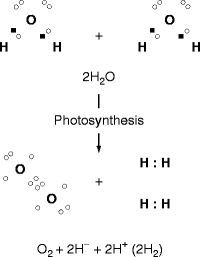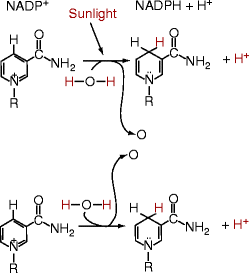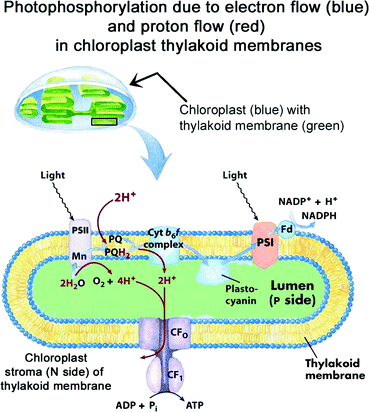Fig. 2.1
Photosynthesis and respiration. Left side is Fig. 1.6. Right side shows photosynthesis in which sunlight and water in the atmosphere are absorbed by plants and algae to generate ATP and NADPH, which make carbohydrates and other organic carbon products from carbon dioxide, which is absorbed from the atmosphere separately. All of the carbon in plants and algae is ultimately derived from a single source, carbon dioxide, and they are called autotrophs. Nitrogen is obtained mostly as ammonia from bacterial metabolism of proteins from dead organism in the soil
2.2 The Light Reaction
Photosynthesis is the sunlight-mediated splitting of water into oxygen and energy. It occurs within a special membrane, the thylakoid membrane, which contains chlorophyll and surrounds a lumen. This membrane resembles the thick inner membrane of mitochondria or oxygen-utilizing bacteria. The thylakoid membrane lies within an organelle called a chloroplast, which is exclusive to leaf cells and algae where photosynthesis occurs. Central to the process of photosynthesis is the light-mediated loss of two electrons and two hydrogen atoms from a molecule of water (Fig. 2.2). Both electrons and one of the two hydrogen atoms pass to NADPH, the equivalent of NADH in mitochondria or bacteria; the other hydrogen atom becomes a hydrogen ion (H+), a proton. When two molecules of water are split by chlorophyll, a molecule of oxygen (O2) is released. For each molecule of oxygen, two molecules of NADPH and two protons (H+) are made (Fig. 2.3).



Fig. 2.2
In plants, light mediates the loss of two electrons and two hydrogen atoms from a molecule of water. See text for discussion of this process

Fig. 2.3
The electrons are passed from water to NADPH. See text
Figure 2.4 illustrates electron and proton transport processes. Electrons are initially energized by sunlight hitting photosystem II (PSII; see figure legend) and transported to photosystem I (PSI). In PSI, sunlight energy is again imparted and the electrons are transferred by ferredoxin, another electron carrier, to NADPH. Electron transport from PSII to PSI is via plastoquinone (PQ), cytochrome b6/cytochrome f complex, and plastocyanin (blue arrows in Fig. 2.4). During electron transport, protons are taken up by plastoquinone (similar to ubiquinone in mitochondria) and released into the lumen (see legend to Fig. 2.4). As they accumulate, the protons start diffusing across the thylakoid membrane through an ATP synthase F0/F1 complex identical to that of mitochondria (red arrows in Fig. 2.4). Electrons that reach PSI are re-energized by sunlight and reduce NADP+ by transport through ferredoxin (blue arrows in Fig. 2.4). The ATP, NADPH, and protons accumulate in the stroma of the chloroplast where they assist in the synthesis of triose phosphate and starch.


Fig. 2.4
Phosphorylation and electron transport in chloroplasts. Electron flow is shown in blue and the proton flow in red. The thylakoid membrane is colored yellow and the lumen is colored green. Light activates photosynthesis site II (photosystem II [PSII]) within chlorophyll whose manganese ions bind water molecules. Light rays attack a bound water molecule, breaking it up into oxygen atoms that combine to form oxygen gas, and hydrogen atoms that split into protons and electrons. Each two molecules of water give two pairs of electrons that are transported along with four protons to plastoquinone (2PQH2). The protons are released into the thylakoid lumen (red arrows) as PQH2 is reoxidized to PQ by the cytochrome complex (blue arrows). Protons accumulate in the lumen (P side of thylakoid membrane) and diffuse into the chloroplast stroma through carriers that synthesize ATP (CF0 and CF1; purple at the foot of figure). ATP is made from ADP and phosphate (Pi) in the chloroplast stroma (N side of thylakoid membrane). As detailed in the text, electrons are transported from PSII to photosystem I ([PSI], pink) where they are activated by light to reduce NADP+ (top right of figure). Extra protons are taken back into the thylakoid lumen by plastoquinone. The plant partitions its electron flow and protons so that the ratio of ATP to NADPH matches its need for assimilation of carbon dioxide into carbohydrates, the primary product of photosynthesis (Adapted from Fig. 19-57 in Lehninger Principles of Biochemistry. D.L. Nelson & M.M. Cox, 4th Ed. 2005. W.H. Freeman & Co., New York)
Stay updated, free dental videos. Join our Telegram channel

VIDEdental - Online dental courses


